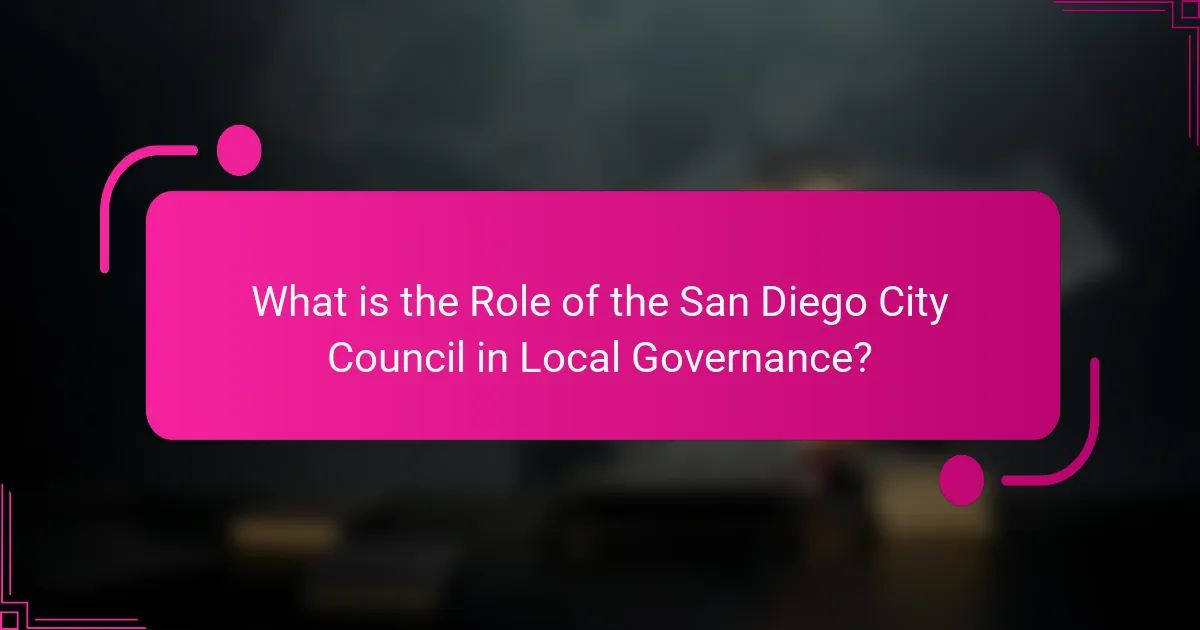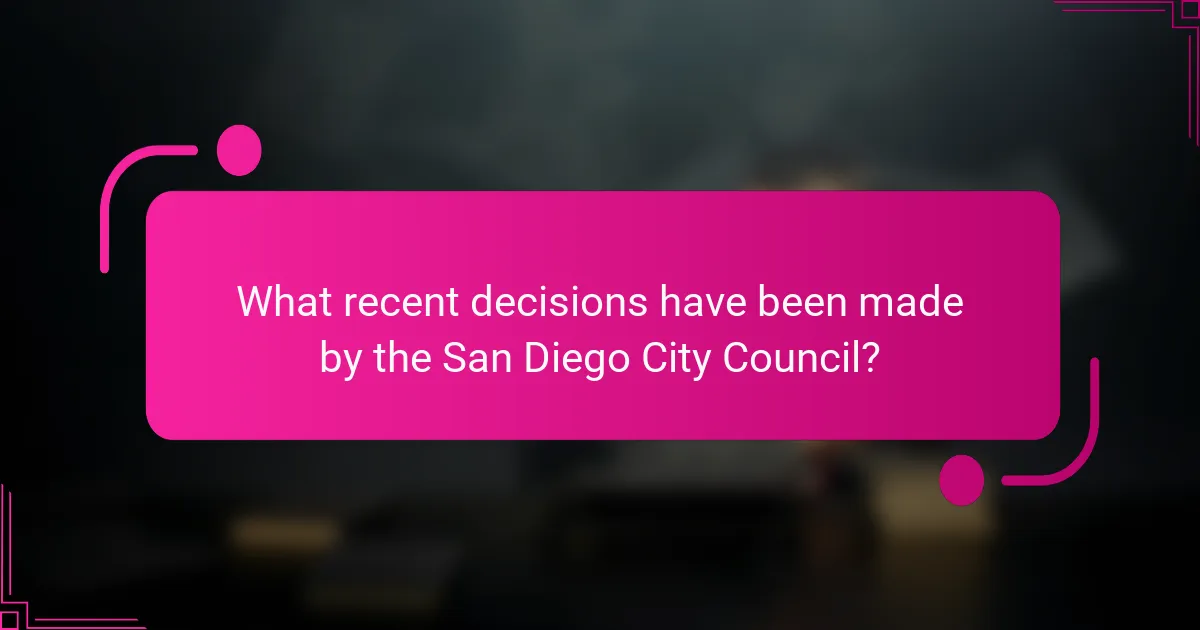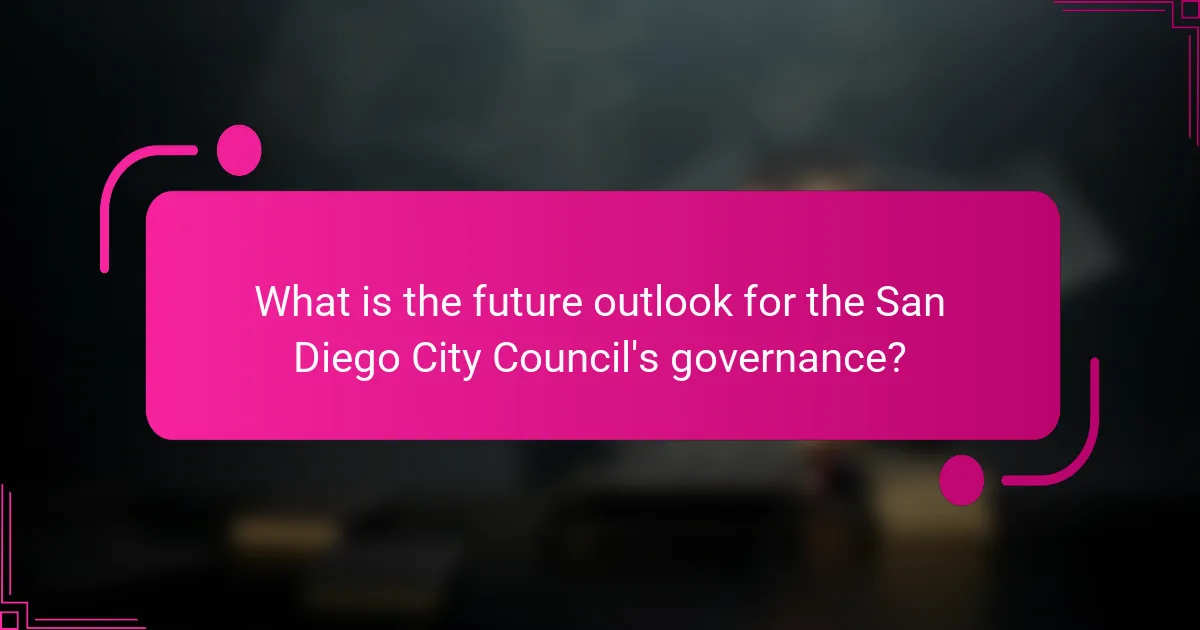
What is the Role of the San Diego City Council in Local Governance?
The San Diego City Council is the legislative body governing the city of San Diego. It is responsible for creating laws, establishing policies, and making budgetary decisions. The council consists of nine members elected from districts across the city. Each member represents the interests of their constituents. The council also oversees city departments and agencies, ensuring accountability and effective governance. Additionally, it plays a key role in urban planning and development decisions. The council holds public meetings to discuss and vote on important issues affecting the community. This structure allows for local representation and citizen involvement in governance.
How is the San Diego City Council structured?
The San Diego City Council is structured as a legislative body consisting of nine elected members. Each member represents a specific district within the city. The council operates under a mayor-council government system. The mayor serves as the chief executive officer, while the council members focus on legislative functions. The council meets regularly to discuss and vote on city policies, budgets, and ordinances. Decisions are made through a majority vote among the council members. This structure allows for representation and accountability in local governance. Each council member serves a four-year term, with elections held in even-numbered years.
What are the key positions within the San Diego City Council?
The key positions within the San Diego City Council include the Mayor, Council President, and Council Members. The Mayor serves as the chief executive officer of the city. The Council President leads the council meetings and represents the council in official capacities. Each Council Member represents a specific district within San Diego. There are nine districts in total, each with its own elected representative. These positions are essential for local governance and decision-making. The structure ensures that various community interests are represented in city policies. The Mayor and Council Members work collaboratively to address city issues. This framework supports effective management of city resources and services.
How does the electoral process work for City Council members?
City Council members are elected through a direct voting process by residents in their respective districts. Elections typically occur every four years, aligning with the general election cycle. Candidates must file nomination papers and gather a specified number of signatures from constituents to qualify. Voters then cast their ballots for their preferred candidates during the election. The candidate receiving the majority of votes in a district is declared the winner. This process ensures that council members represent the interests of their local communities. In San Diego, City Council elections are governed by local election laws and regulations.
What responsibilities does the San Diego City Council hold?
The San Diego City Council holds several key responsibilities. It is responsible for enacting local laws and ordinances. The council also approves the city budget and allocates funding for various services. Additionally, it oversees land use and zoning regulations. The council represents the interests of constituents in their respective districts. It conducts public hearings to gather community input on important issues. Furthermore, the council advocates for policies that address local needs. These responsibilities are essential for effective governance in San Diego.
How does the City Council influence local legislation?
The City Council influences local legislation through the enactment of ordinances and resolutions. It holds the authority to introduce, debate, and vote on laws that govern the city. The Council also conducts public hearings to gather community input on proposed legislation. This process ensures that local voices are considered in decision-making. Additionally, the City Council reviews and approves the city budget, which allocates funding for various programs and services. This financial oversight directly impacts local policy implementation. The Council’s decisions are guided by the interests of constituents, reflecting community needs and priorities. Overall, the City Council serves as a critical link between the government and the public in shaping local laws.
What role does the City Council play in budget approval?
The City Council plays a critical role in budget approval. It reviews, modifies, and ultimately approves the city’s proposed budget. This process ensures that the budget aligns with community needs and priorities. The Council holds public hearings to gather input from residents. During these hearings, council members discuss budget allocations for various departments. The Council also evaluates the financial implications of proposed expenditures. Their approval is necessary for the budget to be enacted. This process is outlined in the San Diego City Charter, which mandates the Council’s involvement in fiscal decisions.
How does the San Diego City Council engage with the community?
The San Diego City Council engages with the community through public meetings and outreach initiatives. These meetings allow residents to voice concerns and provide input on local issues. The council also conducts community workshops and forums to gather feedback. Additionally, they utilize online platforms for surveys and information sharing. Council members often participate in local events to connect with constituents. They maintain communication through newsletters and social media updates. This engagement fosters transparency and accountability in local governance. Community feedback directly influences policy decisions and initiatives.
What methods does the City Council use to gather public input?
The City Council uses various methods to gather public input. These methods include public hearings, community meetings, and online surveys. Public hearings allow residents to voice their opinions on specific issues. Community meetings facilitate discussions between council members and constituents. Online surveys enable broader participation by collecting feedback digitally. Additionally, the City Council may utilize social media platforms to engage with the public. These approaches ensure diverse perspectives are considered in decision-making processes.
How does the City Council communicate its decisions to residents?
The City Council communicates its decisions to residents through multiple channels. These include public meetings, official websites, and social media platforms. Public meetings allow residents to hear discussions and decisions firsthand. The official website publishes meeting minutes, agendas, and press releases. Social media platforms provide real-time updates and engagement opportunities. Additionally, newsletters may be sent to residents to summarize key decisions. This multi-faceted approach ensures transparency and accessibility of information.

What recent decisions have been made by the San Diego City Council?
Recent decisions made by the San Diego City Council include the approval of a new housing development project. This project aims to create affordable housing units in the downtown area. Additionally, the council voted to allocate funds for infrastructure improvements in various neighborhoods. These improvements will enhance public transportation and road conditions. The council also passed a resolution to increase funding for public safety initiatives. This includes measures to support local police and fire departments. Another significant decision was the approval of a climate action plan. This plan focuses on reducing greenhouse gas emissions in the city. These decisions reflect the council’s commitment to addressing housing, safety, and environmental issues in San Diego.
What are the most significant recent legislative actions?
The most significant recent legislative actions by the San Diego City Council include the approval of the Climate Action Plan update. This update aims to achieve net-zero greenhouse gas emissions by 2035. Additionally, the council passed a housing package to address the housing crisis. This package includes measures to streamline the approval process for affordable housing projects. The council also enacted a new minimum wage ordinance, increasing the minimum wage to $15 per hour. These actions reflect the council’s commitment to sustainability, housing solutions, and worker rights.
How do these decisions impact local communities?
Decisions made by the San Diego City Council significantly impact local communities. These decisions can shape policies on housing, public safety, and economic development. For instance, zoning changes can affect housing availability and affordability. Budget allocations influence funding for public services like parks and libraries. Community engagement initiatives can enhance local participation in governance. Additionally, decisions on infrastructure projects can improve transportation and access to services. The outcomes of these decisions directly affect the quality of life for residents. Data from the San Diego Association of Governments shows that local governance decisions correlate with community satisfaction levels.
What controversies have arisen from recent City Council decisions?
Recent City Council decisions in San Diego have sparked various controversies. One major issue involves the approval of new housing developments. Critics argue that these developments contribute to gentrification and displace long-term residents. Additionally, there has been backlash regarding the allocation of city funds. Some community members feel that funding priorities do not address pressing local needs. Environmental concerns have also arisen from decisions affecting urban green spaces. Activists claim that the Council’s actions threaten local ecosystems. Furthermore, transparency issues have been raised about decision-making processes. Residents demand more public engagement and clarity in how decisions are made.
How does the San Diego City Council address current local issues?
The San Diego City Council addresses current local issues through legislation, policy-making, and community engagement. The Council holds regular meetings to discuss pressing matters affecting residents. These meetings allow council members to propose and vote on ordinances and resolutions. The Council also conducts public hearings to gather community input on various issues. Additionally, the Council collaborates with local organizations and stakeholders to address specific challenges. Recent initiatives include measures on housing, public safety, and environmental sustainability. By prioritizing transparency and accountability, the Council aims to respond effectively to the needs of the community.
What initiatives have been introduced to tackle housing challenges?
The San Diego City Council has introduced several initiatives to tackle housing challenges. One initiative is the Affordable Housing Density Bonus Program. This program incentivizes developers to include affordable units in new projects. Another initiative is the Housing Trust Fund, which allocates resources for affordable housing development. The City Council also supports the implementation of the Housing Action Plan. This plan aims to streamline housing approvals and increase production. Additionally, the Council has proposed measures to reduce zoning restrictions. These measures facilitate the construction of accessory dwelling units (ADUs). Lastly, the Council has engaged in partnerships with non-profit organizations for housing solutions. These initiatives collectively address the urgent need for affordable housing in San Diego.
How is the City Council responding to environmental concerns?
The City Council is implementing various initiatives to address environmental concerns. They are promoting sustainable practices in city planning and development. This includes increasing green spaces and enhancing public transportation options. The Council is also focusing on reducing greenhouse gas emissions. They have set specific targets for renewable energy usage. Recent legislation aims to improve waste management and recycling programs. The Council is engaging with community stakeholders to gather input on environmental policies. Additionally, they are allocating funds for environmental protection projects.

What is the future outlook for the San Diego City Council’s governance?
The future outlook for the San Diego City Council’s governance appears focused on increased transparency and community engagement. Recent initiatives aim to enhance public participation in decision-making processes. The council is likely to prioritize sustainable development and climate action in upcoming policies. Additionally, ongoing discussions about housing affordability are expected to shape future legislative agendas. The council’s responsiveness to public needs will be critical in maintaining trust and effectiveness. Historical trends show a shift toward collaborative governance models, indicating a potential for innovative solutions. Overall, the San Diego City Council is positioned to adapt to emerging challenges while fostering community involvement.
What challenges does the San Diego City Council face moving forward?
The San Diego City Council faces challenges related to housing affordability, infrastructure needs, and climate change. Housing costs in San Diego have risen significantly, impacting residents’ access to affordable living. The council must address the growing demand for housing while balancing community concerns. Infrastructure, including transportation and public services, requires upgrades to meet the needs of a growing population. Additionally, climate change poses risks that necessitate sustainable planning and resilience strategies. These challenges require comprehensive policies and community engagement to ensure effective governance.
How might upcoming elections affect the City Council’s composition?
Upcoming elections can significantly alter the City Council’s composition. Changes in voter preferences may lead to the election of new members. These new members could bring different priorities and policies. Historical data shows that shifts in party control often occur during elections. For instance, in the 2020 elections, several incumbents were replaced due to changing demographics and issues. This indicates that upcoming elections may reflect similar trends. The introduction of new members can reshape the council’s decision-making process. As a result, the overall governance of the city may also be impacted by these changes.
What best practices can the San Diego City Council adopt for effective governance?
The San Diego City Council can adopt several best practices for effective governance. First, they should prioritize transparent communication with the public. This includes regular updates on council activities and decisions. Second, implementing data-driven decision-making can enhance accountability. Utilizing metrics and analytics helps to evaluate the impact of policies. Third, fostering community engagement is crucial. This can be achieved through public forums and feedback mechanisms. Fourth, establishing clear performance metrics for council members can promote responsibility. Regular assessments can ensure that goals are met. Lastly, collaboration with local organizations can strengthen community ties. Partnerships can lead to more comprehensive solutions to local issues. These practices contribute to a more effective and responsive governance structure.
How can the City Council improve transparency and accountability?
The City Council can improve transparency and accountability by implementing regular public meetings. These meetings allow citizens to engage directly with council members. Additionally, the council should publish detailed meeting minutes online. This practice ensures that residents can access information on decisions made. Another effective strategy is to utilize online platforms for real-time updates. Transparency increases when residents can see ongoing projects and budgets. Furthermore, the council can establish a citizen advisory board. This board can provide feedback and recommendations to enhance accountability. Lastly, conducting regular surveys can gauge public trust and areas for improvement.
What strategies can enhance community engagement in local decision-making?
Strategies that can enhance community engagement in local decision-making include fostering transparent communication, utilizing digital platforms, and providing educational resources. Transparent communication builds trust and encourages participation. Regular updates on council activities and decisions can keep the community informed. Digital platforms like social media and community forums facilitate broader outreach. They allow residents to share their opinions easily. Educational resources empower citizens to understand local governance. Workshops and informational sessions can clarify the decision-making process. Additionally, creating advisory committees can involve residents directly. These committees can provide valuable insights and feedback on local issues. Engaging diverse community groups ensures that all voices are heard. This approach leads to more equitable and representative decision-making.
The San Diego City Council is the primary legislative body governing the city of San Diego, responsible for creating laws, establishing policies, and making budgetary decisions. Comprising nine elected members, the council represents various districts and oversees city departments, ensuring accountability and effective governance. Key responsibilities include enacting local laws, approving budgets, and engaging with the community through public meetings and outreach initiatives. Recent decisions reflect the council’s focus on addressing housing challenges, public safety, and environmental concerns, while ongoing challenges include housing affordability and infrastructure needs. The article provides a detailed overview of the council’s structure, electoral process, legislative actions, and strategies for enhancing community engagement and transparency.